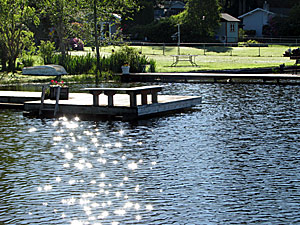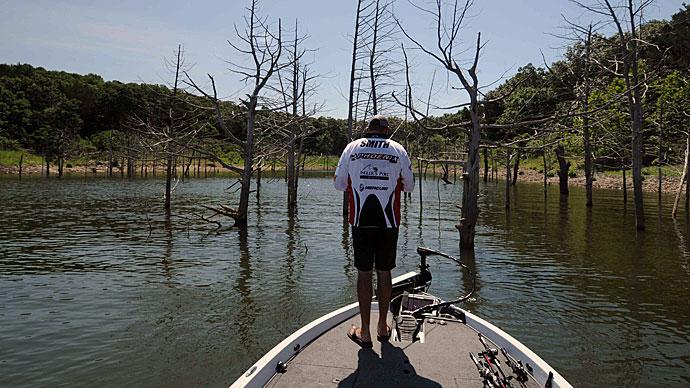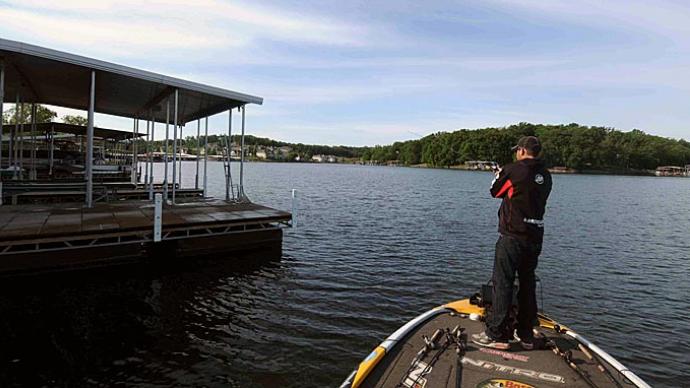
I sometimes think that a dock is the only structure on a lake that is over-fished and under-fished simultaneously. On any given weekend, you can see bass anglers pounding the docks. They may be fishing for fun or in a tournament, but the docks will get hit hard. At the same time, a majority of these anglers are under fishing the docks. They come up to the dock, make a couple of flips, casts, or pitches and then speed off to the next dock. I've even seen anglers catch bass off a dock and still move on to the next dock, never revisiting the area that just gave up a fish.
As a fishing guide in West Central Minnesota and a fanatical tournament angler, I spend almost every day on the water. Seeing other anglers speed-fish down a row of docks is common in my area. I think people fish through docks so quickly for a couple of reasons. One reason is that there are so many docks to fish. Some lakes have many docks, boatlifts, and pontoon boats. I believe anglers see all these potential fish-holding targets and feel they have to hit every one of them! The second reason; we hear, see and read so much about professional tournament anglers fishing fast or power-fishing. Many professional anglers fish fast, but fast fishing is not sloppy fishing. You can bet that these professionals slow down when they hit a productive dock or shoreline holding productive docks. By slowing down and fishing the docks thoroughly, these professionals will wring every last bass off a section or a single dock, and so should you.
What makes one dock or a section of docks more productive than others? I don't think there is an easy ABC answer to this one. However, there are some things that I look for when I'm targeting docks on a new lake. First, I like docks that sit on a quick-breaking shoreline. A good lake map will help you find these areas. Or if you see a section of short docks, just sticking out into the lake one or two sections, that's a good indication of a quick-breaking shoreline. Second, I like docks that have submergent vegetation around them. And any clustering of docks/boat lifts, such as marinas, resorts, or lake association docks, seem to hold more fish than just a single dock. Finally, docks along shallow sterile shorelines, without submergent or emergent vegetation, are usually a waste of time and energy.
You don't have to fish every dock to see if they hold fish. On clear lakes, I will put the trolling motor on high and cruise down a set of docks, not even fishing, just looking. I'm looking for small sunfish, bluegills, or any bass. It has been my experience that a dock holding "gills" will also hold bass. It's a quick way to eliminate some unproductive water.
Generally, the sunnier and calmer the day, the tighter the fish will hold to the docks. Usually, the dock bite will be better in the late morning to late afternoon. The fish will be more prone to roam away from the docks on cloudy days. When it's rainy or cloudy, the areas between the docks may hold more bass than the docks themselves. All docks are somewhat different in design, but there are a couple of high-percentage areas (for bass) that you should look for. First, anytime there is a pontoon boat tied to a dock, under that pontoon is a high percentage area. Second, when a boat or pontoon sits on a lift, right behind the motor will be a washout hole created when the owners power the boat/pontoon off or onto the lift, another high percentage spot. Third, some docks will have fish cages or bait boxes hanging on them (large screen boxes to hold fish or bait). These boxes rarely sit on the bottom of the lake, so there is a space between the bottom of the box and the lake bottom, another very high percentage point. And last, any ladder coming off the dock into the water has the potential to hold a bass or two.
If I had to use just one rod to fish docks (thank God I don't), it would be a 6'6" to 7' medium heavy spinning rod with a size 30 spinning reel loaded with a quality-braided line. This is a great rod to skip docks with, and you can still pitch the corners or hit the open water between docks with this rig. When working a dock pattern, I like to have 3 rods rigged for different purposes. My first rod will be a spinning rod/reel combination that I use to skip under docks and pontoons. Even though I field-staff for Quantum, it's a rod made by Falcon Rods. The rod is a 6'6" MH, rated for 8-15 lb. test line. I believe the rod was a specialty rod made for float tube fishermen. I do not know if it is still in production. For a reel, I use the Quantum Catalyst 30. At first, this may seem like too large a reel for this size rod, but this wide spooled reel allows the line to flow off the spool more smoothly than a smaller reel. This allows me to make skip casts that go way back under docks and pontoons. The second rod is a baitcasting rig I use for most of my flipping and pitching. For the past few years, I've been using Quantum's PTC666F, a 6'6" medium heavy action with a fast taper, rated for 12-25 lb. lines. The fast taper on this rod allows you to make very accurate pitches to targets, and the butt section has the power to handle braided lines and move any fish out away from the docks. I matched this with the new Tour Edition PT reel (the Burner) with a 7:1:1 gear ratio, which quickly picks up the line and handles like a dream. My third rod is usually a spinner or buzzbait rod used to fish the open water areas between docks. I've been using the Quantum PTC706F, a 7' medium heavy with a fast taper. Last year I used the Energy E600PT (6:2:1 gear ratio) on this rod. This year I'm going to use the Dean Rojas signature series rod (PTC706FDR), which is a 7' medium-heavy, fast tapered rod that was designed as an all-purpose "frog rod," but Kermit will have to wait as I'll be tossing buzzers or spinnerbaits with this rod. I will also use the new Energy PT Burner on this rod.
I spool a quality-braided line on all the rods mentioned. If I'm fishing very clear water, I'll use a back-to-back uni-knot to attach a fluorocarbon leader to the braid on my skipping rod. Otherwise, I use just straight braid.
I keep my lure selection very simple. On the skipping rod (spinning), I use an Eagle Claw (Shaw Grigsby) HP hook in 3/0 size. For plastics, I use a Lake Fork Ring Fry. And for a little additional weight, I will place a Water Gremlin Bull Shot sinker in size 1/32 just in front of the HP hook. The sinker gives the rig a little more weight for skipping, and the cone shape helps the rig climb over all the obstructions associated with dock fishing. For the pitching rod, I stick with a Denny Brauer Premier Pro-Model jig, by Strike King Lures, in ½ ounce, matched with a 3X Denny Brauer Chuck for a trailer. And finally, on the blade/buzzer rod, I like to use an Accent Fishing Products buzzbait called the "High Rider Buzz B-2", which has counter-rotation blades behind foam floats, which gives it added buoyancy. This allows you to work this buzzer slower than any other buzzbait I've ever used. Finally, I stick with the "tried and true" Premier Elite in ½ ounce by Strike King Lures for a spinnerbait.
Don't be concerned about fishing behind other anglers. Remember, even though docks are fished hard, there's still a good chance they were underfished. And if you're going to power fish docks, remember that your catch rate will go up if you fish fast but smart. So be safe this summer; we hope to see you on the water.
Wayne Ek is a competitive tournament angler, fishing guide, and writer. In addition, Wayne is field-staffing for Cullerton and Ludwikoski marketing services, doing buyers' shows, sports shows, grand openings, and numerous in-store promotions and seminars. Wayne is currently representing: Ranger Boats, Crystal-Pierz Marine, Quantum, Strike King, Sufix Line, Motor Guide, Salmo Lures, and Bagley Lures.




